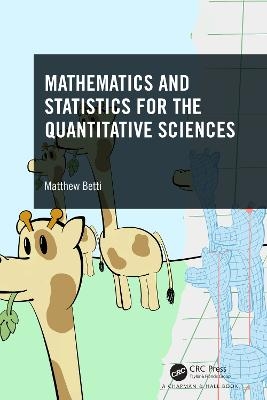
Mathematics and Statistics for the Quantitative Sciences
Chapman & Hall/CRC (Verlag)
978-1-032-20814-5 (ISBN)
Mathematics and Statistics for the Quantitative Sciences was born from a radical reimagining of first-year mathematics. While calculus is often seen as the foundational mathematics required for any scientist, this often leads to mathematics being seen as some, ultimately useless, hoop that needs to be jumped through in order to do what someone really wants to do. This sentiment is everywhere at every level of education. It even shows up in how people stereotype mathematics courses.
What this book aims to do, therefore, is serve as a foundational text in everyday mathematics in a way that is both engaging and practically useful. The book seeks to teach the mathematics needed to start to answer fundamental questions like ‘why’ or ‘how’. Why do we only need to take census data once every few years? How do we determine the optimal dosing of a new pharmaceutical without killing people in the process? Or, more generally, what does it even mean to be average? Or what does it mean for two things to actually be different? These questions require a different way of thinking — a quantitative intuition that goes beyond rote memorization and equips readers to meet the quantitative challenges inherent in any applied discipline.
Features
Draws from a diverse range of fields to make the applications as inclusive as possible
Would be ideal as a foundational mathematical and statistical textbook for any applied quantitative science course
Matthew Betti is an applied mathematician focusing on mathematical modeling of ecological and evolutionary problems, and disease spread. He is currently situated in Sackville, NB at Mount Allison University where he has developed and taught most first year courses in mathematics and computer science. Betti focuses on blending the rigourous with the intuitive to renew interesting in mathematics and statistics in students who see the subjects as a hurdle. Betti also incorporates discussions of ethics and social problems and the place of the mathematical sciences in this context. Betti's research on disease spread and the ecology of honey bees has been published in numerous international journals. His approachable synthesis of complex material has been recognized by a number of presentation awards, and consultation work with governments at all levels.
Section I. Applied Mathematics. The Plot (so you don’t lose it). 1. Functions. 1.1. Anatomy of a Function. 1.2. Modeling With Mathematics. 1.3. Constants and Linear Functions. 1.4. Polynomials. 1.5. Exponentials And Logarithms. 1.6. Functions in Higher Dimensions. 1.7. Contour Diagrams. 1.8. Models In Two Dimensions. 1.9. Variables vs Parameters. 2. Derivatives. 2.1. The Tangent Line. 2.2. Approximating Derivatives of Functions. 2.3. Limits. 2.4. Limits And Derivates. 2.5. Derivative Formulas. 2.6. The Product Rule. 2.7. The Chain Rule. 2.8. Mixing Rules. 2.9. Critical Values. 2.10. Constrained Optimization. 2.11. Elasticity. 2.12. Partial Derivatives. 3. Linear Algebra. 3.1. Vectors. 3.2. Matrices. 3.3. Multiplication: Numbers and Matrices. 3.4. Multiplication: Matrix and Vectors. 3.5. Multiplication: Matrix and Matrix. 3.6. Leslie Matrices. 3.7. The Determinant. 3.8. Eigenvalues & Eigenvectors. 4. Derivatives in Multiple Dimensions. 4.1. Applications. 4.2. Distribution Fitting, Probability and Likelihood. 5. Differential Equations. 5.1. Solving Basic Differential Equations; With an Example. 5.2 Equilibria and Stability. 5.3 Equilibria and Linear Stability in Higher Dimensions. 5.4. The Jacobian. 6. Integration. 6.1. Accumulated Change. 6.2. The Fundamental Theorem of Calculus. 6.3. The Anti-Derivative. 6.4. Fundamental Theorem of Calculus Revisited. 6.5. Properties Of Integrals. 6.6. Integration by Parts. 6.7. Substitution. Section II. Applied Stats & Data Science. Some Context to Anchor Us. Math vs. the World. 7. Data and Summary Statistics. 7.1. What Is Data? 7.2. Data In Python. 7.3. Summary Statistics. 7.4. Ethical and Moral Considerations: Part 1. 7.5. Mean vs. Median vs. Mode. 7.6. Variance & Standard Deviation. 7.7. Ethical And Moral Considerations: Episode 2. 7.8. An Example. 7.9. The Empirical Rule. 8. Visualizing Data. 8.1. Plotting In Python. 8.2. Scatter Plots. 8.3. Outliers. 8.4. Correlation. 8.6. The Anatomy of a Technical Document. 8.7. Bad Plots and Why They’re Bad. 9. Probability. 9.1. Ethical and Moral Considerations: A Very Special Episode. 9.2. Counting. 9.3. Permutations. 9.4. Combinations. 9.5. Combinations With Replacement. 9.6. Probability. 9.7. Properties of Probabilities. 9.8. More Notation. 9.9. Conditional Probability. 9.10. Bayes’ Theorem. 9.11. The Prosecutor’s Fallacy. 9.12. The Law of Total Probability. 10. Probability Distributions. 10.1. Discrete Probability Distributions. 10.2. The Binomial Distribution. 10.3. Trinomial Distribution. 10.4. Cumulative Probability Distributions. 10.5. Continuous Probability. 10.6. Continuous vs Discrete Probability Distributions. 10.7. Probability Density Functions. 10.8. The Normal Distribution. 10.9. Other Useful Distributions. 10.10. Mean, Median, Mode, Variance. 10.11. Summing To Infinity. 10.12. Probability and Python. 10.13. Practice Problems. 11. Fitting Data. 11.1. Defining Relationships. 11.2. Data and Lines. 11.3. Distribution Fitting & Likelihood. 11.4. Dummy Variables. 11.5. Logistic Regression. 11.6. Logistic Regression in Python. 11.7. Iterated Logistic Regression. 11.8. Random Forest Classification. 11.9. Bootstrapping & Confidence Intervals. 11.10. T-Statistics. 11.11. The Dichotomous Nature of P-Values. A. A Crash Course in Python.
| Erscheinungsdatum | 24.11.2022 |
|---|---|
| Zusatzinfo | 18 Tables, black and white; 155 Line drawings, color; 155 Illustrations, color |
| Sprache | englisch |
| Maße | 156 x 234 mm |
| Gewicht | 800 g |
| Themenwelt | Mathematik / Informatik ► Mathematik ► Analysis |
| Mathematik / Informatik ► Mathematik ► Angewandte Mathematik | |
| Mathematik / Informatik ► Mathematik ► Statistik | |
| ISBN-10 | 1-032-20814-7 / 1032208147 |
| ISBN-13 | 978-1-032-20814-5 / 9781032208145 |
| Zustand | Neuware |
| Haben Sie eine Frage zum Produkt? |
aus dem Bereich


